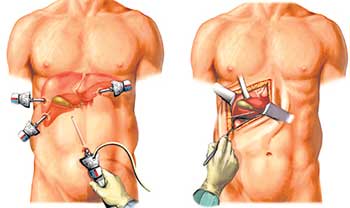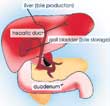
A distended sac sometimes has to be taken outMrs. Samarasekara, a 42-year-old housewife was complaining of abdominal discomfort following meals for a few months. She had a dull pain in the upper abdomen with a bloated feeling and nausea, on and off. But thinking it was indigestion, she ignored the symptoms. One afternoon, she had an abdominal pain, more severe than what she usually experienced, mainly in the right side of her upper abdomen. It persisted and she felt as if it was radiating to the back, and up to the shoulder area. Gradually she developed fever and vomited a few times. The pain worsened when she took a deep breath or coughed. She was taken to the nearest hospital, where she was admitted to the surgical casualty ward.
The doctor on call examined Mrs. Samarasekara, and made the necessary records in the bed head ticket. She had fever - 1010 Celsius and was mildly dehydrated. Her pulse rate was 92 per minute, on the high side. Her tummy was painful to the touch. She felt uncomfortable when the doctor tried to examine the right upper area. "It seems that the patient is having cholecystitis," said the doctor, after seeing the report of the ultrasound scan which was performed immediately. Her husband was puzzled, not knowing what it meant. "There is a sac like structure called the gallbladder inside the abdomen which usually stores the liquid called bile produced by the liver until it gets released to the gut. Bile is important for digestion of food. Now, the gall bladder is inflamed, that is called cholecystitis and we suspect an infection there," the doctor explained. "But all of a sudden, an infection?" her husband asked. "This is a fairly common condition, lots of people have stones inside the gallbladder. One in three women and one in six men have gallstones developing at some point in their lives. But it does not give rise to symptoms. Once a stone obstructs the drainage pathway of the gallbladder, it gets distended with bile, and the wall gets inflamed. Also the microorganisms in the gut can infect it," the doctor said, explaining Mrs. Samarasekara's condition. Mr. Samarasekara was worried whether she would need surgery, as this was a surgical ward. "No, not right now, we'll treat her and see," the Dr. replied, instructing the nursing staff to keep her fasting. An intravenous line was inserted to a vein, through which saline and antibiotics were given. She was also given another injection of strong pain killers to alleviate the pain. At the same time the staff was asked to monitor her status, fever etc. Despite being rare if the gallbladder ruptured, it could disseminate the infection throughout the body, which could prove dangerous. Two days on, Mrs. Samarasekara was making a good recovery. Her fever was down, she had no pain and she was allowed to take oral sips. After another day, since there were no complications, the consultant surgeon decided to discharge her, with oral antibiotics for another 4 days. She was also given a date for surgical removal of the gall bladder. All gallstones do not make surgical removal of the gallbladder necessary. Only about 4 to 6 people develop symptoms out of 100 people with gallstones. But since Mrs. Samarasekara had already developed a complication, cholecystitis, the chances of her developing it again were high. Such patients are considered for surgery. Otherwise an incidental finding of gallstones can be left untreated without any problem.
"Doctor, do you think my indigestion symptoms are due to this condition?" asked the patient. "We cannot be certain about that. It could be, but those symptoms of indigestion could be due to gastritis, reflux or other problems as well. There are patients who undergo Cholecystectomy or removal of the gallbladder but some of them still suffer those symptoms even after the surgery. For you also, it could work, it could not. But once we remove the gall bladder there will not be further episodes of cholecystitis, like this," the Dr assured. Mrs. Samarasekara left hospital, with the date of surgery fixed for 6 weeks later. Mrs. Samarasekera was admitted to the ward on the specified date and the basic investigations were done to get an idea about her haemoglobin level, kidney functions and condition of the heart. The surgery was scheduled for the next morning. An anaesthetist assessed her to check whether she was suitable for the surgery. The planned surgical procedure was a Laparoscopic Cholecystectomy. The next day, surgery went ahead as planned and after recovering from anaesthesia, Mrs. Samarasekera was sent to the ward. She had no problems except for mild pain from the surgical wounds. Given pain-killers for that, it was a relieved patient who went home on the second day, with no complications. Open surgery or keyhole surgery? Cholecystectomy could be done as open surgery by making an incision of a few centimetres in the right upper abdomen, but the popular method is laparoscopic surgery or "keyhole surgery".
|
|
||||||
|| Front
Page | News | Editorial | Columns | Sports | Plus | Financial
Times | International | Mirror | TV
Times | Funday
Times | Medi Scene || |
| |
Reproduction of articles permitted when used without any alterations to contents and a link to the source page.
|
© Copyright
2008 | Wijeya
Newspapers Ltd.Colombo. Sri Lanka. All Rights Reserved. |

